Newsletter
Spring 2016
No. 43
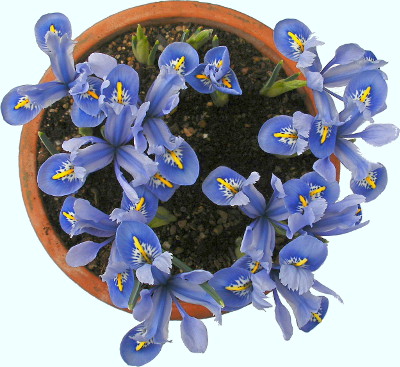 Iris reticulata ‘Alida’
Iris reticulata ‘Alida’Newsletter |
 Iris reticulata ‘Alida’ Iris reticulata ‘Alida’ |
What a wet winter! I think we’ve all had enough of sploshing around in wellies, (thankfully Worcestershire escaped the worst of the floods this time), and poking forlornly about in the mud to identify and rescue those first tender green shoots from the armies of molluscs who have relished the conditions.
So we are marching on into spring and with many plants having flowered unseasonably early I wonder what the coming months will bring? There’s always plenty to do and new plans to put into action. This is the year that I am determined to tackle my ‘Bank of Shame’ (or RBS as John calls it - I’ll leave you to work that one out!). You can follow my progress and see the pictures in the ‘Spotlight’ on our website and I’d appreciate any ideas on how to manage this awkward space. It is a bank running the length of our house along the drive and has always been a problem with poor soil and erosion combined with weeds and a tangle of ivy. Hopefully I may be able to report good progress by the Autumn Newsletter. We’d love to hear about plans for your garden - they do say that resolutions only succeed when you share your plans with others.
Meanwhile we have a great programme of meetings and outings, there will be new plants to acquire and find space for amongst the old favourites. You will see from Jenny’s article on the Conservation Scheme that we have some suggestions for plants worthy of conservation and I would urge you to take a look round your garden and see which plants have continued to perform through the years but may now be hard to find, then get propagating for our monthly sales table and for our Plant Sale in June and let Judy Pollitt and Jenny Constant know if you think you have something special. (I must include a request from Judy that you collect unsold plants after the meetings as we do not have space to look after them from month to month.)
But perhaps you are a designer rather than a propagator and I hope you will take inspiration from our celebrity guest speaker, Diarmuid Gavin; I’m sure he will be out to challenge us to look at our gardens in different ways.
We will have had our AGM by the time that you read this and I am really pleased that not only has Worcestershire Group membership grown, but that we also have volunteers willing, not just to take on committee roles, but also to contribute so much by providing refreshments, organising outings and helping arrange and tidy the hall each month. I don’t want this to make us complacent however; we should all be looking to encourage our friends to come along and welcome visitors to join in with our activities. There are many ways that you can become more involved in the group and in doing so gain more from time spent with like-minded people engaged in doing what we all enjoy.
I hope you all enjoyed the new-look Autumn Newsletter. I have to thank Sally Sahingoz for the layout and also for introducing us to a local printer who quoted such a competitive price that we were able to move to full colour without financial penalty. This means that photos can now be placed adjacent to the relevant text and, that an unlimited number of pictures can be accommodated, adding to both visual appeal and informative content. I hope this will stimulate you to submit more contributions with accompanying pictures. If you don’t trust yourself to write a full feature article, a photo with a short explanatory caption will be welcomed. Please, remember, the newsletter is not just a vehicle for official notices, it also presents an opportunity to pool our knowledge and experience. So let’s use it!
Preparations are in hand for a garden tour next year departing Sunday 25th June and returning on Thursday 29th. We shall be based in Tiverton, Devon, visiting gardens in the surrounding area. Full details will appear in the autumn newsletter when booking forms will be available.
This Pelargonium ‘Crocodile’ was a sell-out when members visited Doreen Fahey’s garden on the North Yorkshire garden tour.
Over the last few months the list of plants in the Conservation Scheme has seen a number of comings and goings. With the criteria for new additions being strictly applied, and the culling of misidentified plants, departures have exceeded arrivals, resulting in a shorter higher quality list.
A number of plants have left the scheme as Successes, because they are now consistently more widely available, according to the RHS Plantfinder. Examples which have been grown in Worcestershire Group are:
Rudbeckia laciniata 'Starcadia Razzle Dazzle' with its star shaped single yellow flowers with greenish central knobs and very dark green, deeply laciniated (slashed, jagged) leaves. Worth having for the name alone!
Chrysanthemum ‘Chelsea Physic Garden’ with its deep red flowers, flecked with gold;
and Heuchera ‘Brownfinch’ which has silver, mottled green leaves with many spikes of terracotta-brown flowers which are very long-lasting, and a magnet for bees.
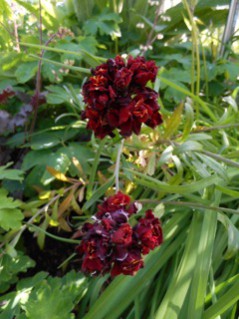
On the subject of Heucheras, we hope H. ‘Burgundy Frost’ is on the way to wider availability too. The National Co-ordinator, Helen Mount, is in contact with a nursery which is keen to propagate this, and they have asked for some decent sized ‘mother’ plants in order to build up a reasonable stock. Helen is obviously keen to follow this up, as there is a lot of competition in the Heuchera field, with many flashy varieties that perhaps have more initial appeal than the HPS Good Doers. We are grateful to Leila Mantle for providing propagation material.
I mentioned the ‘weeding out’ (sorry couldn’t resist a very obvious pun!) of wrongly named and misidentified plants. A number of these were Irises, including ‘Banbury Gem’, which several of us grow. This doesn’t mean that we should not continue to grow and love it, just that we must no longer pass on propagated material under that name.
As regards newcomers to the scheme, Ann Hooper has recommended two new Phlox. One of each has gone to the scheme’s National Co-ordinator for appraisal, and the second pair to growers in our own Group.
The importance of propagating Conservation Plants is a recurring theme. It really is the engine that drives the whole process; when plants are taken but not returned the feedback loop fails and plants get stuck on the list, sometimes for years. One such is the evocatively named Erysimum ‘Bloody Warrior’. Jan Vaughan has written more about this in the accompanying article.
I shall end as I always do, by inviting the compulsive propagators among you to come and join us. Now is just the right time to request a plant for delivery in October. An illustrated plant list can be found on the HPS website ( www.hardy-plant.org.uk/conservation/conserve.php ) and I can provide full plant profiles if you want to know more.
Speakers have been booked for the next 12 months – and there are inspiring talks ahead.
After our AGM next March, our speaker will be Helena Garrish, who’ll be talking about The Life and Legacy of Henry Avray Tipping.
Mr Tipping, who died in 1933, was architectural editor of Country Life magazine and wrote many books on gardens and country houses. He lived in Monmouthshire and designed 20 gardens, as well as his own. Helena lives in his last house, High Glanau Manor, near Monmouth, where the garden has been restored back to his original 1923 design.
We actually kick off 2017 with someone who was also a Country Life writer – he was gardens editor there for a while. The man in question is author and all-round good egg Tim Richardson.
He’s written some wonderful books about gardens in the UK and America but he’ll be talking to us about The Gardens of the Oxford Colleges, the subject of his latest publication. He was due to speak to us this year but had to cancel at very short notice due to a mistaken double booking. He’s an informed, witty speaker and involved in a number of UK gardening associations, including the Chelsea Fringe and the National Trust. He also edited New Eden, the contemporary gardens magazine.
For a lighter topic, join us for our Christmas meeting, where, after a lovely lunch together, we’ll be hearing from an acclaimed photographer, Michael Warren. He’s an award-winning snapper and holds the lifetime achievement award of the Garden Media Guild. He’s a fellow of the Chartered Institute of Horticulture and will be taking us on a trip around London in 2016 in his talk, Flowers In The City. It will include the Chelsea Flower Show, the Lord Mayor’s Show and spin-offs including France’s Courson Flower Show.
Details of the full programme will be on our website.
HPS Worcestershire Group will once more be flying the flag for the Society at the Malvern Spring Festival this year. The stand will feature Ranunculaceae, promoting the specialist group, as well as new publications and the HPS seed exchange.
See the May spotlight for a report and photos.
Lyn Miles is a pillar of her local HPS group and was most helpful in advising us on suitable gardens to visit on our garden tour to Dorset in 2009. She recently sent this email invitation for members to visit her own garden, which she is opening for charity, should their travels take them down to the Salisbury area.
Some of you will already know that I hold a collection of over 100 Pulmonarias for the Pulmonaria Group of the H.P.S. plus I have an even larger number of named snowdrops, over 200! Combined with grasses and other “deads”, plus numerous hellebores there will be plenty to see, so my garden at WESTCROFT, BOSCOMBE VILLAGE, Salisbury, Wilts. SP4 0AB is opening from 11 a.m. to 5 p.m. for Cancer Research UK, (£2.50 entrance) on the following dates:
Sunday & Monday, 24th & 25th April, also the last Sunday & Monday in May and June, 29th & 30th May, 26th & 27th June and finally, Sunday 31st July and Monday 1st August.*
Homemade Soups, tea/coffee and scrummy cakes! Inside if cold and wet!
It will be lovely to see you, easy parking in the field opposite, garden on main A338, signed on the day. If field too wet, alternative parking will be signed.
P.S. Westcroft, described as a wilderness paradise in the 2012 yellow book, is a wild garden (and wildlife friendly) but not quite so wild early in the year! Depending on the season I will probably have Oil beetles in the garden and lots of bees because pulmonarias are one of the best food crops for bees early in the year, we should all grow them!
Garden also suitable for group visits (14 or more), please phone me on 07787852756 or e-mail me on lynmiles@icloud.com
I now have a garden web site www.westcroftgarden.co.uk , just a few new photo’s needed!”
We wish Lyn a successful season and admire her enterprise.
Our fifth annual Plant Sale will take place on Saturday 11th June at Peopleton Village Hall, with the doors opening to the public at 2.00pm and closing at 4.00pm. Last year’s sale was the most successful yet raising over £700 towards the Group’s funds and a vote of thanks is owed to all those who contributed to this achievement.
Once again, we are calling on members to participate in order to build on that success and make this year’s results even bigger and better. You can do this by kindly donating plants as well as helping on the day – and, importantly, don’t forget to spread the word about the sale. The more people we can attract the better.
Over the last year we have been pleased to welcome an appreciable number of new members to the Group and for their benefit the arrangements for the day are detailed below.
The Hall will be open and the plant reception at the entrance manned from 12 noon. However, to avoid a last minute rush, all plants should be delivered no later than 1.30pm, and preferably much earlier. Free tea and coffee will be available to members from 12.30pm with facilities in the hall for people to eat a packed lunch. Please wear your HPS lapel badges throughout (available in the foyer as usual) so that we can raise the profile of the Hardy Plant Society to visitors.
In order to build up a reputation as being a plant sale of note, our emphasis must be on offering quality plants. Therefore, it is essential that your donated plants are well presented and weed-free in clean pots as the team responsible for receiving and pricing the plants will have little time to tidy them up. All plants should be clearly labelled either with their common name or botanical name if known. Any additional information such as flower colour, flowering season, height and growing conditions etc. will help to sell them. Any plants left on the table at 4.00pm will be taken to the next meeting for the donated table. However, from an organisational point of view it would be preferable if you could please remove any of your unsold plants if you are able to stay until the close of the sale.
Lists will be circulated at forthcoming meetings inviting members to sign up if they are able to supply plants and/or help on the day. This will assist in planning and ensure that we have sufficient helpers to make the event run smoothly. If you can supply plants but are unable to attend the sale, they can be dropped off earlier at my house in Cowsden.
Finally, besides the obvious fund-raising aspect, and the heightened profile of the Society within the local area, the plant sale also allows us all to contribute to the Group in whatever way we can, and to experience a sense of achievement from working together as a friendly and enthusiastic team of plant lovers. So do come along and enjoy the day.
It was on the group holiday to Yorkshire in June that John McGhee whispered in my ear, “in confidence, Stella……” to tell me that the Worcestershire group were looking into the possibility of hosting the Chelsea HPS stand for 2017, which will be the HPS’s 60th anniversary. I told him that I thought it sounded very exciting, and somehow became a member of the organising group. Linda (Marsh) had offered to do the design, and was already looking at possible plants and combinations as we went round some beautiful Yorkshire gardens. John and Linda are also looking at presenting a display that incorporates elements to the design that have never been attempted at Chelsea. These features will be revealed as the design progresses.
Our first formal meeting was in August at the Arts Centre in Pershore, where we discussed a possible design, as well as details such as labelling. Bob Brown had been approached to supply plants, and Linda had made an initial selection from the catalogue of “Just Must”, Ed Brown’s wholesale nursery. At the beginning of October a small group of us arrived at the nursery to pot up around 80 plug plants and select some larger plants which Ed had advised would not be ready in time from plugs. We will be potting up more in the Spring; meanwhile, the plants are being regularly checked by Hazel Bartlett. Unlike many Chelsea exhibitors, we’re not in a position to hold back or bring on plants and so can only use those which are normally in flower in May.
At the October meeting, Jan announced the proposal to the group and Linda explained her background in horticulture and garden design, which includes designing a garden for the Hampton Court Show. We are lucky to have someone with her experience to take on such a prestigious project.
Other issues we’ve had to discuss have been the size and shape of the stand and who will build it, who will be able and willing to set it up, and what the judging criteria are. We are still looking for ways to incorporate the 60th Anniversary theme, and Linda is happy to take suggestions for plant combinations. Linda and John will be attending a session for new exhibitors at Chelsea this year, and then our final proposal can be submitted.
This is one in a series of guides published in association with Royal Botanic Gardens, Kew and came to my attention when Sally Gregson came to talk about epimediums at my local horticultural society. The following month, I met Sally again at the first AGM of the new Hardy Plant Society Shade and Woodland Plants Group and, having volunteered to produce a newsletter for the group, asked if I could review her book.
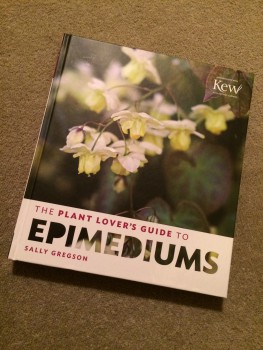
I have always grown epimediums in my garden; they are part of the spring parade with dainty flowers in yellow, orange or red and good foliage. An old favourite, Epimedium pinnatum subsp. colchicum lines a path along one side of my herb garden and the new, bronze-marbled leaves and sprays of dainty yellow flowers are eye-catching in the spring sunshine. These traditional epimediums are tough, performing even in those difficult places in dry shade, and I wouldn’t be without them. But I had not realised that I was missing some of the most exquisite members of this genus and it was these ‘showgirls’ that Sally had come to talk about. Her book opens with her story of how she stumbled across a collection of unfamiliar epimediums on a nursery visit one day and beginning with Epimedium ‘Enchantress’, resulted in a quest to collect these plants and trial them in the garden with her other favourites, hydrangeas.
Here is the story of introductions from Japan and China that are new to most gardeners and describes the conditions they need to grow well, suggesting planting combinations that complement their delicate colours and leaf shapes. How could you not be intrigued by a chapter titled ‘Designing with Bishop’s Hats, Barrenworts, and Fairy Wings’? In this section Sally divides epimediums into groups according to flower size, habit and soil requirements and it’s not long before you are planning more shady areas in the garden to accommodate your growing wish list. The helpful little lists of epimediums for different situations are ideal for quick reference.
There are detailed descriptions of 123 epimediums, taking us on a journey of exploration with the plant hunters and hybridists, each illustrated with beautiful photographs. This is followed by a section on growing and propagating epimediums, which starts by reassuring the reader that ‘Epimediums are essentially amenable plants with a great willingness to grow’. I had never considered the option of growing epimediums in containers and yet it makes perfect sense to make a feature of the exquisite flowers and allows some manipulation of soil pH to extend the range of plants you can grow.
There is always something to mar one’s enjoyment and epimediums are prone to attack by vine weevils, and rabbits apparently find them delicious. I hate to tempt fate, but so far my local rabbits don’t seem to have developed a taste for them.
I’m not sure epimedium flowers are blowsy enough to be ‘showgirls’, but I absolutely love the idea of ‘hang-gliding spiders’! There is something for everyone here, from the new gardener to those with experience of shade planting, and I am sure this book will be a popular addition to many gardeners’ bookshelves.
Win Botterill was pleasantly surprised to receive an email from Julia Dale following January’s meeting where she supplied a tray of almond slices. These had been so appreciated that a number of members had requested the recipe which Win has written out below.
But this is not a Mary Berry recipe; it comes with a more interesting provenance. It was given to Win by a Yugoslavian lady who was her neighbour when they lived in Monmouth in the early ’80s. The lady’s husband had been a prisoner of war in this country and when the Nazis took their home and lands she trekked over with her two children to join him.
Win recalls how she was also taught how to use all the bits of a pig’s head but thankfully has forgotten!
Almond Slices
Grease and line an 11”x7” Swiss roll tin. (18cmx28cm)
Oven 190C Gas 5
Ingredients
4½oz 128g plain flour
3oz 85g softened butter
1½oz 42g caster sugar.
Method
Mix shortbread to stiff dough and press into tin. Prick all over
Bake No5 for 10mins
Remove from oven.
Spread 4 tablespoons raspberry/strawberry/redcurrant jam...although I used cherry today.
Topping
3ozs 85g SR Flour
1 egg, 1 egg yolk
1 TBSP baking powder
3oz 85g caster sugar
3 oz. margarine 85g ( though I use butter)
Tsp almond essence.
1 oz 28g flaked almonds.
Beat topping ingredients until smooth (except flaked almonds)
Spread over jam. Sprinkle over almonds.
Return to oven for 20mins, until risen.
Cool in tin for 15mins. Turn out whole and slice.
Enjoy!
2016 is a special year for gardeners as we celebrate the work of the famous garden designer `Capability` Brown.
The events organised throughout England to celebrate his work should be of particular interest to HPS members. Brown transformed 270 country estates, creating gardens with gently rolling contours, serpentine lakes and winding footpaths. Strategically planted trees framed beautiful views of the surrounding countryside. Here in Worcestershire we are fortunate to have Brown’s first commission as a `landscape artist`, Croome Park, which he called “my first and favourite child”.
Lancelot Brown was born in Kirkharle in Northumberland in 1716; his father was probably a tenant farmer. He attended school and then became a gardener on one of the local estates where the owner was undertaking drainage work. Brown acquired practical skills but he was also ambitious and intelligent. At the age of 24 he was fortunate to be employed by Lord Cobham of Stowe to manage the kitchen garden. Stowe was the most famous garden in England at that time. It was at Stowe that Brown met William Kent who became his teacher. Kent was the first exponent of the new picturesque English style in garden art. Brown worked with Kent for six years and then became Head Gardener at Stowe. By that time he was starting to practise as a landscape artist and architect.
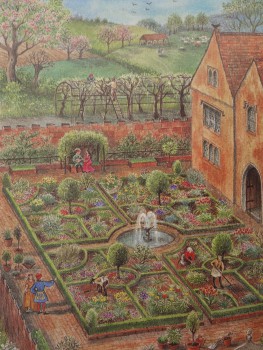
Formal style 17th century garden
Gardens on large estates before the 18th century were formal with a geometric design, influenced by Italian, Dutch and French styles. The most famous gardens were designed by André Le Nôtre, garden artist to Louis XIV of France, his grand masterpiece being Versailles. Some of you may have seen the recent film “A Little Chaos” with Kate Winslet which features Le Nôtre. A local example of that type of garden can be found at Hanbury Hall near Droitwich, where the parterre garden has been reinstated by the National Trust. Gardens of that era were seen as places for socialising or solitary recreation; an extension of the house.
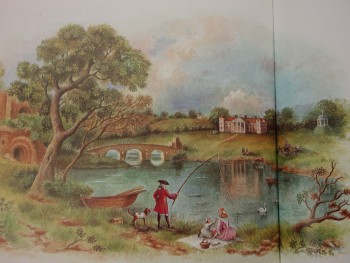
18th century English landscape style garden
English landscape gardeners of the 18th century were influenced by the landscape paintings of Claude Lorrain and Nicholas Poussin. However they wanted to create the scenes in the paintings in three dimensions, with real trees, rolling hills, lakes and picturesque buildings. The English wanted their gardens to
appear `natural`, to express their love of nature, but also to be economical to maintain. French style gardens such as those at Château de Villandry in the Loire valley required an army of gardeners.
Of course Brown would not have had the opportunity to demonstrate his talent without his wealthy patrons. In the 18th century, the nobility of England lived on their estates, not in London. Their income was mostly derived from agriculture and land rental. Between 1750 and 1825 the population of England increased from 11 million to 21 million so more food had to be grown. New ideas increased yields, and landowners made greater profits from agriculture. The income of the nobility was also supplemented by profits from investment in overseas trade, and the exploitation of natural resources such as coal, iron ore and limestone on their land. Men of taste and education were keen to embrace new ideas and improve their estates. They could afford to employ architects and landscape artists, like Brown, to redesign their houses and gardens. There was an enormous social gap between Brown and his aristocratic patrons, yet they recognised Brown`s ability and genius, and many of these men became his friends.
In 1751 following the deaths of William Kent and Lord Cobham, Brown moved to London. He set up in practice as an architect and landscape artist in Hammersmith, which at that time was the best market garden and nursery region in London.
In that same year, Brown received his first major commission from the 6th Earl of Coventry. The Earl asked Brown to redesign his house, Croome Court, build a new church and landscape the gardens. Today we find it surprising that a man who had started life as a gardener could become an architect, but in the 18th century there was more flexibility and a man of Brown`s ability could do this. At Stowe, Brown had met and worked with some of the greatest architects and designers of his day such as Vanburgh, Bridgeman and Kent. At Croome he collaborated with Robert Adam who designed the interior of the church, part of the interior of the house, and some of the buildings in the park.

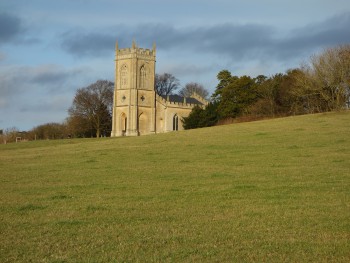
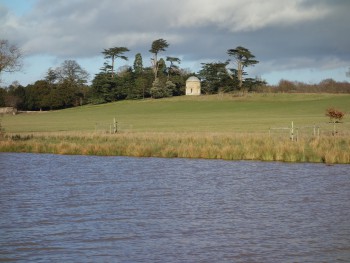
The estate at Croome had been described by the Earl as a `morass`. Brown drained the marshy areas and created a serpentine lake. He planted trees to enhance and frame views, and used a sunken fence or `ha-ha` to make the design appear seamless. The final result is a testament to Brown`s vision; he himself would never have seen his design grow to maturity. A substantial number of Brown`s original trees remain to this day and have been verified as his plantings by an expert from the RHS centre at Pershore during a recent tree survey at Croome Park.
England has no native conifers other than yew, and no native evergreen trees other than holly. Brown was responsible for introducing many new species of tree to England including several North American conifers. He used 24 different types of oak in his designs.
Although he created shrubberies, Brown was not known for flower gardens. At Croome it was the Earl of Coventry who was the keen plantsman. The Archivist at Croome, Jill Tovey, has bills showing that the Earl ordered plants from 84 nurseries; the archivist at Kew has verified 54 of these. There is a list of plants used at Croome in a document “Hortus Croomensis” dated 1824. However many of the plants listed were not used by Brown in his design but added by the Earl of Coventry.
The years 1760-70 were good ones for Brown, he travelled the length and breadth of England working at Blenheim, Chatsworth and St John’s College, Cambridge. His `back to nature` style was admired and he was valued for his talent and practical skills. Patrons also appreciated his honesty and organisational ability. When he first visited an estate he would discuss its `capability` for improvement; hence his nickname `Capability` Brown. In his later career he could be described as a civil engineer, altering the topography of the land and creating lakes as well as planting trees. His work also influenced the landscape movement abroad, especially in Germany, and the British colonies in North America. After Thomas Jefferson visited Blenheim and Stowe, he decided that his home, Monticello, should be landscaped as an English park.
In 1765 Brown was appointed as Surveyor to His Majesty’s Gardens and Waters at Hampton Court Palace with an annual stipend of £2000. He planted the Black Hamburg vine at Hampton Court, which three centuries later still produces 3000 bunches of grapes each year.
At a time when opportunities in life were determined by background and family connections, Brown rose to the top of English society through merit. The man who began his working life as a gardener mixed with the intellectuals of his day - Samuel Goldsmith, David Garrick, Dr Samuel Johnson and the architect, James Wyatt. King George III is said to have enjoyed Brown’s company.
From 1770 England faced twenty years of problems abroad both in Europe and America, but the English garden revolution continued.
Brown’s landscape designs would not have occurred in nature. The gardens he created were an improved version of nature, more pleasing to the human eye because of the harmony, proportion and balance achieved. His landscaping work continued until his death in 1783, his legacy was being continued by Humphrey Repton.
I hope that you will visit some of the impressive gardens designed by `Capability` Brown this year; there are special events and exhibitions planned throughout England for you to enjoy.
Bibliography:
Capability Brown by Edward Hyams.
Croome Park, a souvenir guide by the National Trust.
Jill Tovey, Archivist Croome Park. Personal communication.
Further reading:
The Garden Magazine – RHS March edition see article by John Phibbs “ Mover of Mountains”.
Just in case you were wondering – we did finally get enough orders from members to get a half-price discount from the Fertile Fibre compost company, a family firm based in Hereford.
They were chosen as the No 1 multi-purpose compost in trials by Gardening Which? Magazine – and their normal price for a 60-litre bag was £16. By getting orders for a total of 57 bags – including five for seed compost – the cost went down to £8 a bag.
A total of 13 members placed orders – and we’ll keep in touch with them to get their opinions on the compost later this year. If it’s as good as we hope it is, we may run the scheme again in future.
‘Mags’ Lewis has been gardening all her life. A member of the Worcestershire Group of the Hardy Plant Society since just after it was formed in the ’90s, she’s had the same garden since 1968. Despite major changes in the last few years, that may all be about to change again. Mick Dunstan has been talking to her …
So, Mags, I suspect you like a little bit of gardening.
Yes, indeed. I started apparently when I was about 18 months old in Quinton in Birmingham. The story goes that I followed my Dad down the veg garden as he was thinning out the beetroot, I went behind pulling out what was left and got a smack for my troubles. That was my first gardening experience and it didn’t put me off. I was the eldest of five children and took over the front garden when I was about eight.
And you’ve been looking after your Broadwas garden for a long time now.
It was 48 years on February 8 this year. When we moved in, it was like a field – with two Pershore Purple plum trees and the rest 4ft high in sow thistles. It’s about 50ft wide by 100ft deep at the back and I dug a 4ft patch to put the stuff I’d brought from our house in Droitwich. Pretty soon we were in the garden every day. There was a lot of rubbish in the soil, which is red clay. My son, Simon, used to make animals out of it! I put down a lawn, a veg patch and one of the metre-wide borders we made then is now 12ft deep.
And things have continued to change?
Yes. We had a badminton court on the lawn as the kids grew and when the shuttlecock kept flying over into next door’s, we planted a row of cordon apples to try to stop that. The greenhouse was a lovely Mother’s Day present. I also got an electric propagator, in 1971 I think, which is still working. I love growing things from seed.
It’s quite clear you love your plants.
Most things in the garden have come from seeds. I’ve bought some things, robinia and trees but a lot of perennials I’ve begged off people or they’ve been nice presents. I got a wheelbarrow for one birthday. We planted three silver birches in 1971 –5ft tall and as thin as a pencil. They grew to 70ft, overshadowed more than three quarters of the garden for years and just before Christmas I had them taken down. It’s made a tremendous difference.
Any particularly favourite plants?
I really like epimediums. I love peonies but haven’t got a lot. Hellebores I also love and grow hepaticas and penstemons – I take a lot of cuttings of those. I’m in a frost pocket here so they can just disappear. I also like plants such as sarcococcas, euphorbias and asters.
You had a model train line running around the back garden at one time?
My husband, Richard, who died about 10 years ago, was a keen model maker and won national awards. He was a perfectionist – I’m definitely not a perfectionist. We had a dual-track raised train line built, a large oval, around part of the back garden. The track was nickel silver. After he died, I had it taken down and I sold parts of it. His close friends had the choice of some of his models to remember him by. They came from right across the country – Southampton, Liverpool and other places - and I got my garden back.
One thing I know about you, Mags, is your encyclopaedic knowledge of plant names.
I’ve always had a good memory. My old boss said I had a 110 per cent memory, but nowadays I sometimes have to think a bit more than I did. The other day I looked at a plant in the garden and it was two days before the name came, suddenly, out of nowhere.
You’ve been telling me about a book you’ve been reading lately.
Ah, yes. It’s The Sceptical Gardener by Ken Thompson. It’s a dip-in book, I think, a collection of articles he’s written over the last few years. He is sceptical about things, and so I am, I think. There’s a chapter on growing by lunar planting, for example, but the whole of the book is a really good read. So much so, I bought a copy for a friend as a present.
And now, Mags, you’ve put the house up for sale.
The garden’s getting a bit big for me, to be honest. I’ve been busy in it nearly every day for the last 48 years and it feels a bit like a loss. If it doesn’t sell, I’m quite happy to stay. If it does, I’ll move to a smaller garden nearer my son and daughter in Worcester. My heart wants to stay but my head knows I probably have to go. My friend Helen helps in the garden and we’ve been potting up plants to take if I do move. If I stay, I’ve got plans as well. I’ve decided I’ll put three trees back, but smaller ones – one for spring, one for summer fruit and one for autumn colour. I’ll get them at Frank Matthew’s nursery in Ledbury that Nick Dunn featured on Gardener’s World recently.
Do you belong to other gardening clubs?
I like the Hardy Plant Society – the diversity and the knowledge different people have. They like their plants and they’re happy talking about gardening. I’ve now joined Martley Gardening Club locally as well. I started a gardening club in Broadwas in 1976 but we closed down last year because we weren’t getting enough people. Times are changing and so many new houses have the tiniest gardens. Some garden societies can seem elitist but I don’t think gardening is anything to do with money or position. I think gardening’s about love, really. When I’m in the garden, whatever I’ve got to worry about I’m in a different world - a good bit of weeding and all your troubles are gone. That’s how I like it.
We didn't come on the Group tour to Cornwall, but do stay quite often on the Roseland peninsula and so drive past Poppy Cottage. We've visited a couple of times, and on the second visit I saw a plant used in several different sorts of place in the garden with attractive serrated bright leaves which I liked. I couldn't find a label so asked its name and what it 'did'. Shown a photo, I especially liked the dark brown wiry stems, and the little white flowers, though unassuming, looked plentiful. It didn't seem like an aster to me, but I have a lot to learn!
We had thought an unfussy plant with pale flowers would be good for the difficult, dry patch almost under the rowan and this seemed worth a try. 'Don't stake it', I was told. 'I tried that and it looked awful – stiff and unhappy.'
So into the difficult patch it went, watered for the first year. The many small white flowers have yellow centres, both flowers and centres turning pinkish as they age, and the dark stems are very attractive as they loll about round other plants. The plant lives well with others, but can brighten up that corner on its own, and lasts a long time.
Attractive, useful, a reminder of the Roseland, cheers me up when I look at that 'difficult' patch - lots to like!
Not long ago we were sympathising with gardening friends in Spetchley who were overrun by rabbits. The rabbit army has since decamped, embarking on an eastward offensive and setting up its new HQ in our neighbour's garden. Ours has been designated as a foraging and entertainment zone. Spetchley is rabbit-free. After two years suffering under this alien yoke the far-reaching decision was made last summer to fence the entire garden. This has been no mean undertaking and the decision was not taken lightly, not least on account of the cost but also because of the challenges it presented.
If you Google images of rabbit fencing you will see pictures of neatly executed fencing stretching across level fields of close-cropped grass, the corner posts braced by angled posts. Detailed instructions explain how the 5 to 8cm diameter posts should be driven into the ground to a depth of 30-40cm and spaced approximately 2m apart. On the outward-facing (field) side you dig a 25cm wide trench to a depth of 10cm sloping away from you. The lower 20cm of the 100cm wide netting is laid horizontally in the bottom of the trench and covered with earth, packed down, before the rest is stapled to the vertical posts, stretching it tightly between the posts as you go. A 2.5mm diameter stretching wire is stapled to the posts about 1cm above the top of the netting and in a final step the netting is clipped to the wire using special ring clips. If necessary and to make a neater job, the tops of the posts can then be cut off to about 5cm above the wire. What could be simpler than that?
In reality things are rarely straightforward. Our garden adjoins neighbouring properties and fields, the boundary largely comprising mature field hedges made up of hawthorn, elm, ash, elder, privet, holly, ivy, quickthorn and brambles. The whole extends to 2/3 acre. The fence would need to be erected on our land i.e. within the garden. This would mean working from the ‘wrong’ side. To dig a trench on the outside would be impossible due to the hedge and burying the netting in the ground, even on our side, would entail chopping through a tangle of roots. A neighbour’s tightly clipped leylandii hedge forms the boundary at one point posing further problems while hardcore under a thin layer of top soil would make it difficult to hammer the posts in along a further stretch. Sleepless nights followed, wrestling with all the problems presented by the site.
With the years the hedges had grown wider and for this reason and because rabbit fencing is unsightly it was decided to cut the hedges hard back and set the fencing as deep into the hedge as possible. In this way the hedge would, it was hoped, grow back and conceal the fence. In some parts earlier stock-proof fencing had been smothered by the overgrown hedge. Where possible this would now be exposed and the netting stapled direct onto it without the need for new posts. And so, one by one, work-round solutions were found and after days of back-breaking work the task was finally completed and bottles were broken open. But the euphoria was short-lived.
After only a couple of weeks the alarm was raised. A solitary rabbit had been sighted in the garden to be followed some time later by a further sighting, but this time of two. Two rabbits is bad news! A council of war was called and a state of emergency declared. Border-strengthening measures were introduced and the border fences regularly patrolled. No point of entry or exit could be identified. It was concluded that the supposed intruders had in fact been residents. I had in effect created a safe-haven or zoo for bunnies.
Rabbits, I learned, tend to live al fresco through the summer, happy to exist in amongst the vegetation. Given that winter had now set in and that they were deprived of their usual quarters next door they had to have made a home in our garden. An entry point was eventually discovered leading to the foundation of the summer house. It was again something of a revelation to me just how small a space rabbits can squeeze through. This gap was no more than 7cm high, if that. The entrance was duly sealed off but an inspection the following day revealed a perfect round hole, the diameter of a drain pipe, adjacent to the foundation of the summer house. This had been bunny's escape route, his bolt hole. This was sealed off and the whole site isolated by a secondary fence.
Bunny then moved his HQ to the tool shed, again squeezing underneath through an impossibly small gap. A similar sequence of 'cat-and-mouse' events followed leading to the adoption of extreme measures which will hopefully prove to be the final solution. At present the jury is out.
The whole episode has taught me a great deal about rabbits and their behaviour and habitats. They do not like wet weather and while you may see them during daylight hours on a fine day, especially the young, they are mainly active at night. Sightings at this time of the year (winter) are less common and you may be lured into a sense of false security. Look for the result of overnight excavations. They seem to prefer loose earth to dig in and will often work away at the roots of one or two particular plants, especially ones you have recently acquired. Half the battle in defeating them is to locate their quarters and in particular the entrance they use. Scrape a little loose earth in front of the entrance and see if it has been disturbed overnight indicating that the burrow is still in use. Look for their droppings. Learn to differentiate between the excavations of forgetful squirrels looking for your walnuts and those of rabbits creating a new warren.
Gardening journals frequently publish lists of rabbit-proof plants. It is understandable that rabbits would not relish hairy or spiky-leafed plants but these lists often include plants that have suffered at the teeth of our bunnies. And the flavour of the year in 2015 can be some other tasty morsel in 2016. Rabbits are curious and will sample tender young shoots, either eating them or spitting them out if they don't appeal. I am sure that they either forget which plants they have sampled or try them a second time to be sure that they really did not taste right. How else can you account for their seeming passion for garlic tops, for example? Rejected plants are often pulled up and contemptuously cast aside; I eventually gave up re-planting a couple of Salvia Amistad seedlings last year and consigned them to the compost heap. Rabbits also have a special sense which detects those plants you particularly value. Otherwise why would they nibble off and destroy a choice eryngium costing £6.99 whilst not touching all the others in the garden? And the carrot you tempt them with in the humane trap should be organic and not from a supermarket! (If you should be successful with one of these contraptions, you are supposed to despatch the poor creature to that rabbit warren in the sky – it is an offence to release it on to someone else's land.)
I do not profess to be an authority on the subject but I would be happy to talk to any member troubled by rabbits if they feel they could benefit from my experience.
Well I wanted to avoid reference to the obvious ’50 Shades’ title, so I’ve borrowed this one from an Australian paper called “The Age” whose gardening editor used it in 1987. I heard on the radio this morning that scientists have identified the gene responsible for grey hair so that with a little gene manipulation there may be no more ‘grey and silver’.
The explanation for rambling on in this vein is the constant talk about attracting younger members to all manner of societies, including the HPS, set against a passage I read in Miracle Osler’s book, In the Eye of the Garden (1993):
So heads up ladies, and apologies to the grey-haired gentlemen! Let’s impart our love of gardening to the next generation, remembering that most people don’t garden until acquiring their own plot and then it may just need tidying whilst providing a playground and sports field for the family!
(The full title of that article was ‘Silver Shades among the Grey add Charm’, but I thought that might be going too far!)
When most gardens are closing at the end of the season, the Picton Garden at Colwall near Malvern is opening its doors to visitors. A charitable trust, the garden is home to the Plant Heritage National Collection of Asters or Michaelmas Daises and is managed by the Picton family, owners of the adjacent Old Court Nurseries on the same site. From mid-September to the end of October the display of Asters is at its peak and the garden is a blaze of colour.
A useful map guides you through the garden which is divided into distinct areas. Some are densely planted with Asters, whilst other areas have mixed plantings incorporating other late-flowering perennials of which several of the more unusual ones were sadly not labelled. A great deal of clearing and planting has recently taken place especially at the extremity of this 1.5 acre garden which now incorporates many unusual ornamental trees and shrubs. We were surprised to see that a Metasequoia had been planted in the relatively confined space of the Damp Garden along with a Taxodium distichum or Swamp Cypress. The garden possesses the Wow factor in abundance and must be a delight in late spring too.
Representing the third generation of Pictons to be involved with the garden, Helen Picton was on hand to greet visitors while father Paul was walking round the garden, camera and notebook in hand. Like many people, we grow a number of the more popular Asters in our garden such as ‘Little Carlow’, ‘Monch’, ‘King George’, A. divaricatus etc. and several lacking names. Helen was able to confirm the identity of novi angliae Aster ‘Andenken an Alma Pötschke’
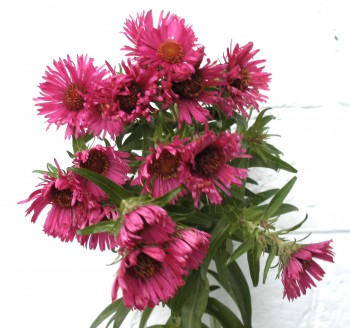
Symphyotrichum novae-angliae
‘Andenken an Alma Pötschke’
with its dramatic cerise –pink flowers. The identity of a strong-growing, deep purple-flowered Aster from our daughter’s garden had eluded us for a number of years. Helen could positively identify as A. ‘Violetta’. As with many of the tall novi angliae asters, the woody stems of this plant tend to be bare or the lower leaves turn brown and die off. Given its height (c.1.50m) siting it in the centre of an island bed or at the back of a deep border where its nakedness can be concealed is not a problem. Identifying a third, equally tall pink- flowered plant proved more problematic. It remains query A. ‘Red Cloud’.
If asked to name your favourite aster on a visit to the Picton Garden I think you would still be there today. Not a favourite but most unusual was a prostrate aster called Snow Flurry. This grows to no more than 10cm in height with arching stems densely covered in tiny white flowers and would grace an alpine garden. Particularly striking was A. x frikartii ‘Wunder von Staffa’ with clear lavender-blue flowers on branched willowy stems, not unlike Monch and similar in height. But the plant that could not be resisted was A. turbinellus. A tall, 1.20m Prairie Aster, this has tiny, smokey-blue flowers that seem to float on tall, delicate willowy stems. As such, it could be regarded as a see-through plant which offers a number of planting options in borders that are already overfilled.
Other plants that drew the eye were Salvia ‘Embers Wish’, a new half-hardy hybrid, with bright coral-red flowers, and Persicaria ‘Indian Summer’. This had attractive foliage and tiny bright-red flowers. It is apparently a new introduction from India. We were surprised to come across a tall-bearded iris in flower. This was thought to be Iris ‘Golden Immortal’ from Cayeux, France, which, according to Helen was enjoying its fourth flowering in 11 months, extraordinary even for a listed remontant iris.
So, when we pass from summer into autumn and the days begin to shorten, don’t miss the opportunity for one last garden visit – to the spectacular Picton Garden.
Please note that asters have been reclassified and should now be called Symphyotrichums. Until I can get my tongue round the word I shall continue to call them Asters or good-old-fashioned Michaelmas Daisies.
Do please use this website to source your plant needs from within the Society making a token donation of £2 to Society funds. A mystery donor was able to supply Jackie Davies with Achillea ‘Moonshine’ which she lost after (only) 40 years and I shall be looking to replace a Helianthus salicifolius when I can be assured that the bunnies have finally been excluded from the garden. A Rudbeckia occidentalis ‘Green Wizard’ was another bunny victim I would like to see reinstated.
A Study Day organised by the
Hardy Geranium Group
on
Saturday June 11th 2016
near Worcester
Reception 9.15 am
Plant Sales
Talk by Bob Brown
“Geraniums – Restraint and Discrimination”
Garden Visit
to National Collection of Geranium macrorrhizum, x cantabrigiense and
sanguineum at Brockamin
Coffee and Tea; bring your own lunch
Members £10, non-members £15
Further details from:
Margaret Stone 01905 830370 or stone.brockamin@btinternet.com
or
Oliver Folkard, 1, Baron’s Close, Fakenham, Norfolk, NR21 8BE
Under the Data Protection Act you should know that your name, address, e-mail address and telephone number are held as paper records and/or on a computer file for administrative purposes. No personal information will be disclosed to any organisation or person outside the Group without the member's permission, except to compare data with that held by the Hardy Plant Society National Administrator. If you are concerned about the methods used to store your data please contact the Secretary, Lyn Maile.